Video
Improving Care in Heart Failure
%jwplayer%
The MD Magazine Peer Exchange “Managing Heart Failure Today: Current Best Practices and New Treatment Options” features a panel of physician experts discussing key factors to consider when making treatment decisions for patients with heart failure and their own clinical experiences with recently approved medications for the treatment of heart failure.
This Peer Exchange is moderated by Peter Salgo, MD, professor of medicine and anesthesiology at Columbia University College of Physicians and Surgeons, and an associate director of Surgical Intensive Care at New York-Presbyterian Hospital.
The panelists are:
- Michael Felker, MD, MHS, professor of medicine and chief of the Heart Failure Section at Duke University School of Medicine, in Durham, NC
- Milton Packer, MD, Distinguished Scholar in Cardiovascular Science, Baylor Heart and Vascular Hospital, Baylor University Medical Center, in Dallas, TX
- Scott Solomon, MD, Senior Physician and director of Non-Invasive Cardiology at Brigham and Women’s Hospital, and Edward D. Frohlich Distinguished Chair and professor of medicine at Harvard Medical School, in Boston, MA
- John R. Teerlink, MD, director of Heart Failure at San Francisco Veterans Affairs Medical Center and professor of medicine at UCSF in San Francisco, CA
Peter Salgo, MD: This has been an amazing discussion. It’s been one of the best I’ve ever been privileged to moderate. I want to thank you guys for being here. But before we leave, [I’d like to ask each of you] to give us one last thought.
Michael Felker, MD, MHS: I agree that this was great, and I think we’ve really emphasized the key points. I think having new drugs is a challenge, in some sense, because people are having to grapple with how to use them. But for the first time in a long time, we have an opportunity to meaningfully alter the natural history of this quite severe clinical problem. So, I think that makes it an exciting time for all of us. Thank you.
Peter Salgo, MD: Dr. Packer, before I give you your 30 seconds, I want to thank you for being here today. It’s an honor to be at your side.
Milton Packer, MD: Thank you. When you give a patient a diagnosis of heart failure, you’re giving them a diagnosis of a progressive, lethal disease. In order to treat that, you have to pull out all the stops. This is not [accomplished via] small incremental changes over long periods of time, depending on whether the patient comes in and says they feel better or not. This is [accomplished via] maximal inhibition of all of the deleterious effects that cause heart failure to progress. Right now, we actually can do a better job than we’ve ever been able to do before. But it does require physicians to spend more time and make decisions. If they don’t do it, patients won’t live longer.
Scott Solomon, MD: I think it’s great to have options. And in heart failure with reduced ejection fraction, we now have quite a few options. We really have very good evidence and science to guide what we do. But it’s very important to realize we haven’t cured heart failure. We’ve made dents with these new therapies in heart failure.
There are different types of heart failure. We’ve not made these kind of dents, for example, in heart failure with preserved ejection fraction, yet. We only really have symptomatic therapy. We’re trying. We’re testing therapies in that area, as well. We haven’t made a dent, yet, in acute decompensated heart failure. So, I think that in another few years, you’re going to have to have us back to talk about, hopefully, some of the dents that we’ll be able to make in those areas.
John R. Teerlink, MD: Thank you for this opportunity. I have to agree with my colleagues. It’s been a pleasure to work with you here today. I agree with all of your points. I think one of the things we need to do is continue to look forward [and also examine] areas that we haven’t addressed yet, such as acute heart failure.
[We also need to] recognize that we didn’t touch at all upon device therapies for heart failure, which is also something that’s hugely underappreciated and not implemented as much as it should be. In addition, there are many other alternatives to treating the comorbidities that impact upon heart failure—such as atrial fibrillation. So, we have a lot more work to do and hopefully we’ve inspired folks to do it.
Peter Salgo, MD: Thank you all, once again, for being here. I want to thank you [the viewers] for being with us too. This has been a great discussion. I think the take-away, if I’ve heard our guests correctly, is that you’ve got to take what these folks have been telling you and do something about it. You’ve got an opportunity to help your patients. It’s up to you to do that.
So, on behalf of our panel, I want to thank you for joining us. I’m Dr Peter Salgo, and I’ll see you next time.





